Fragrant, beautiful, and utterly unique, water lilies have long been celebrated and implemented in ceremonies, religious symbolism, medicine and art throughout history. Comprised of at least 58 species, native varieties of water lilies can be found in nearly all parts of the globe from North and South America to Europe and Africa as well as throughout Asia. Though they come in numerous colors, shapes and sizes they are all bound by one commonality: the need for a calm, freshwater habitat.

It's believed that this very characteristic is what inspired the water lily's Latin (botanical) name, Nymphaea which is derived from the ancient Greek "numphaîa" and "númphē" or as we know it, "nymph." Featured prominently throughout Greek and Roman mythology, nymphs were young female spirits (i.e., lesser deities, not goddesses) who were associated with growth and fertility and closely tied to specific natural places – particularly lakes, ponds and streams and occasionally wells and forests. Given their exquisite beauty and propensity for creating enchanting colonies of color through whatever body of water they inhabit, it's no surprise that water lilies were named for these charming divinities.


Comentários